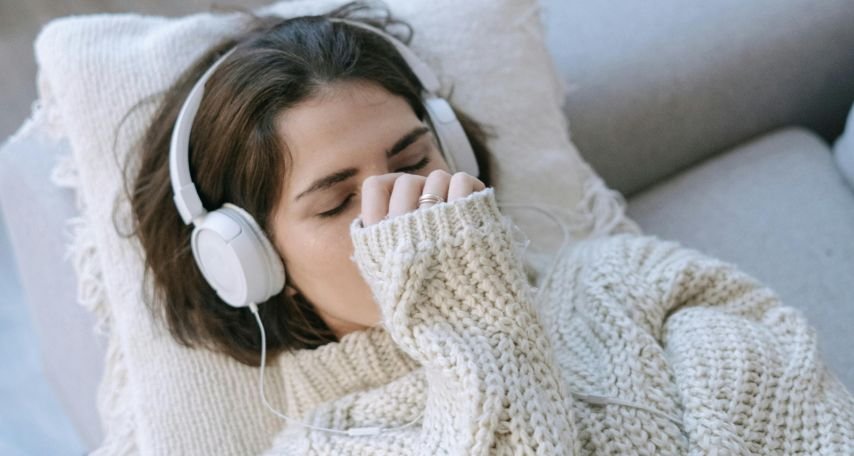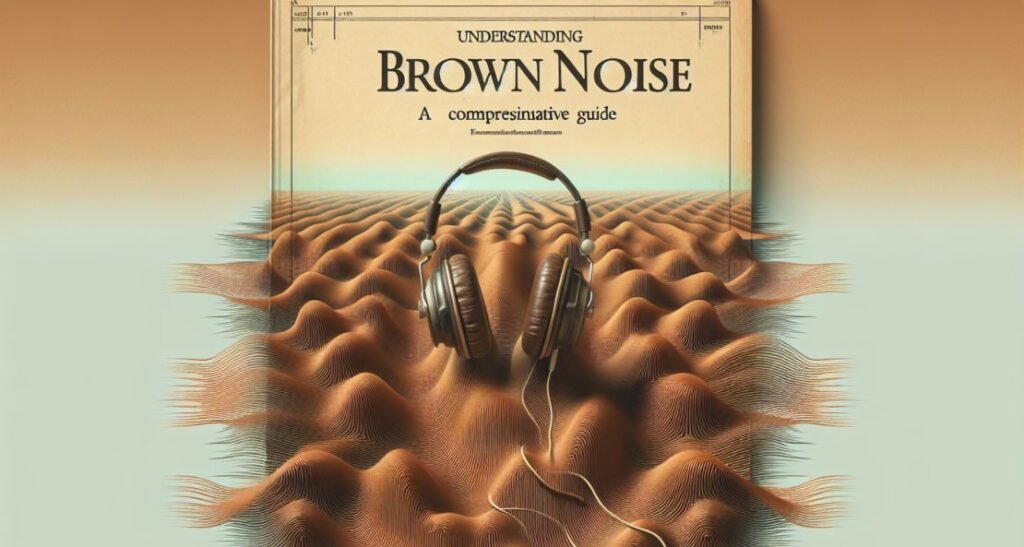Brown noise, also termed Brownian noise, offers a unique auditory experience with a deeper, more resonant sound compared to pink noise or white noise, highlighting its significance in relaxation and sound therapy.
It garners attention for its potential to improve sleep and reduce stress, establishing a foundation for its use in various wellness applications.
This guide will explore what brown noise is, including its scientific background and practical uses, such as brown noise for sleep and meditation.
Additionally, it will delve into the ways brown noise can be integrated into daily routines to enhance mental health and well-being.
Understanding Brown Noise

Brown noise, named after Robert Brown, who discovered Brownian motion, is a unique type of sound that encompasses all frequencies audible to humans, with a distinctive emphasis on lower frequencies.
This sound pattern is often likened to natural noises such as waterfalls, thunder, or heavy rain due to its deep, resonant quality.
The creation of brown noise involves a process similar to that observed in Brownian motion, where tiny particles move in a fluid in a random, erratic pattern, which is mimicked in the sound’s signal changes.
Characteristically, brown noise has more energy at lower frequencies, which contributes to its deeper and more soothing sound compared to white or pink noise.
This type of noise is generated by integrating white noise, which contains equal power across all frequencies, and then emphasizing the lower frequencies while reducing the higher tones.
This results in a sound that decreases in intensity by 6 dB per octave, giving it a “damped” or “soft” quality.
The specific sound wave characteristics of brown noise, such as the power spectral density being inversely proportional to the square of frequency, make it distinct.
This quality means that as the frequency decreases, the energy or power in the sound increases, leading to its characteristic deep, rumbling sounds that are reminiscent of an aeroplane at night or strong natural elements like ocean waves or strong winds.
Benefits of Brown Noise

Reducing Stress and Anxiety
Brown noise, with its deeper and smoother sound profile, has been shown to be particularly effective in reducing stress and anxiety.
The soothing properties of brown noise can help calm the mind, making it an excellent choice for relaxation and stress relief.
Its ability to drown out distracting background noise also contributes to a more tranquil environment, which can further aid in reducing anxiety levels.
Enhancing Sleep and Concentration
One of the key benefits of brown noise is its ability to enhance sleep quality.
By masking disruptive background sounds, brown noise creates a consistent auditory backdrop that can help individuals fall asleep faster and enjoy deeper sleep.
Additionally, the calming effect of brown noise extends to improving concentration.
It helps to create a focused environment by blocking out external distractions, thus allowing for better concentration and productivity, especially in work or study settings.
Supporting Mental Health and Well-Being

Brown noise has been found to support mental health by aiding in the management of ADHD symptoms and providing relief from tinnitus.
It fits well with other therapeutic tools, such as sensory toys or stress relief pillows, making it a versatile addition to mental wellness practices.
Furthermore, the relaxing effect of brown noise on the body and mind can help lower blood pressure and heart rate, contributing to overall well-being and a healthier stress response.
Brown Noise and Mental Health
Brown noise, characterised by its low frequencies, is increasingly recognized for its mental health benefits, especially in aiding relaxation and improving sleep quality.
This type of noise, often compared to the sound of a river current or strong wind, can be particularly soothing, mimicking the comforting sound inside a mother’s womb, which is why it is often used in sound machines designed for sleep, such as the Sound+Sleep SE or the LectroFan line.
These devices offer a variety of non-looping sound options, including white, pink, and brown noise, tailored for different needs such as sound masking and concentration enhancement.
In clinical settings, brown noise has shown promise in supporting individuals with tinnitus, providing a soothing backdrop that can help mitigate the symptoms of ringing in the ears.
Additionally, small studies have suggested that brown noise can improve memory and aid in concentration among children with ADHD, supporting the Moderate Brain Arousal (MBA) model, which posits that certain sounds can enhance cognitive functioning in this group.
This has led to its use not only in personal environments but also in educational and therapeutic settings to create a conducive atmosphere for learning and relaxation.
Moreover, the versatility of brown noise extends to its application in managing anxiety.
It helps reduce reactivity to ambient noises, which is particularly beneficial for individuals sensitive to sudden sounds.
This feature allows for a calmer environment, promoting better concentration, relaxation, and sleep, which are crucial for overall mental well-being.
While the effectiveness of brown noise can vary based on individual preferences and conditions, its broad application and safety at moderate volumes make it a valuable tool in the arsenal of mental health support.
How to Incorporate Brown Noise into Your Routine

Utilising Brown Noise Through Apps and Devices
- Accessing Brown Noise: Many apps and websites offer a variety of brown noise tracks that can be accessed with ease. This allows users to experiment with different sounds to find the one that best suits their needs, whether for relaxation or concentration.
- Employing Brown Noise Machines: For a more immersive experience, brown noise machines and devices are available that provide a consistent sound environment. These devices are especially useful in settings like bedrooms or study areas where maintaining a constant background noise can help improve sleep quality or focus.
Creating an Optimal Brown Noise Environment

- Noise-Cancelling Headphones: Using noise-cancelling headphones can significantly enhance the brown noise experience by blocking out external distractions. This is particularly beneficial in noisy environments or workplaces.
- Minimising Distractions: To further improve concentration and relaxation, it is recommended to close windows to shut out street noise and turn off any distracting electronic devices.
- Volume Considerations: It is crucial to maintain the volume at safe levels, ideally below 70dBA, to avoid any potential hearing damage while still reaping the benefits of brown noise.
Adapting Brown Noise for Various Activities
Brown noise’s versatility makes it suitable for a range of environments and activities.
It can be effectively incorporated into routines that involve sleeping, working, studying, or engaging in relaxation and meditation practices.
The consistent and high-quality sound environment created by brown noise machines facilitates a focused and relaxed state, aiding in various mental and physical wellness activities.
It is generally safe to experiment with brown noise to determine its effectiveness in aiding focus or improving sleep, provided the volume remains within a safe range.
Individual responses to brown noise may vary, highlighting the importance of personal testing to ascertain its benefits.
Conclusion
Through this comprehensive exploration, we’ve unearthed the significant potential of brown noise in enhancing mental and physical well-being.
By delving into its unique characteristics, from the soothing deepness of its sound profile to its application in reducing stress, enhancing sleep, and boosting concentration, the guide underscores the versatile utility of brown noise across various aspects of daily life.
The insights into its scientific underpinnings, coupled with practical advice on incorporating it into routines, equip readers with a well-rounded understanding of how brown noise can be leveraged for health and wellness.
The discussion also opens avenues for further exploration of brown noise’s therapeutic potential, suggesting its growing relevance in sound therapy and mental health support.
Emphasising the importance of personal experimentation to gauge effectiveness, the guide invites readers to integrate brown noise into their lives, whether for relaxation, improved focus, or a better sleep routine.
To conclude, the exploration of brown noise signifies a promising approach to managing the contemporary challenges of stress and distraction, highlighting its significance in fostering a conducive environment for mental health and well-being.
FAQs
1. Can I listen to brown noise throughout the night?
Yes, you can listen to brown noise all night, as it is not harmful by itself.
However, it is crucial to ensure that the volume is not too high to avoid damaging your hearing.
Moderate volume levels are recommended when using brown noise or any ambient sounds to aid sleep and productivity.
2. What exactly is brown noise?
Brown noise is a type of sound in which the lower frequencies are significantly amplified while the higher frequencies are much softer.
This creates a deep, rich sound similar to the heavy patter of rain or the powerful rush of a waterfall, making it distinct from other types of noise like white or pink noise.
3. Which colour of sound is most effective for sleep?
Green and brown noises are considered the most effective for inducing sleep, with brown noise being particularly beneficial for maintaining sleep.
Pink and white noises are also useful, as they help block external noises that might disturb sleep.
4. Why might someone prefer brown noise to white noise?
Individuals might prefer brown noise, also known as red noise, because it has a deeper and more consistent tone than white or pink noise.
The steady, low-intensity sound of brown noise is excellent for masking disruptive background noises, which is why it is often used in sound conditioners in places like therapists’ waiting rooms.


